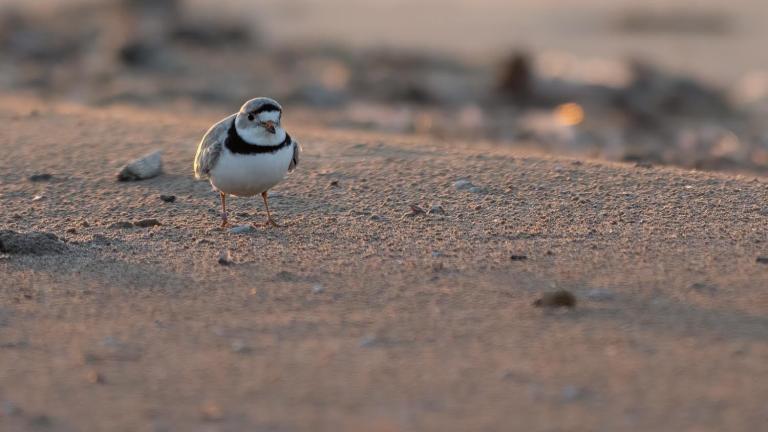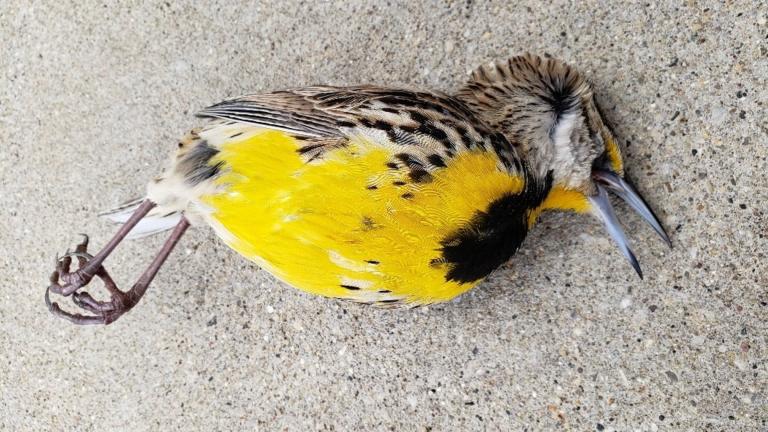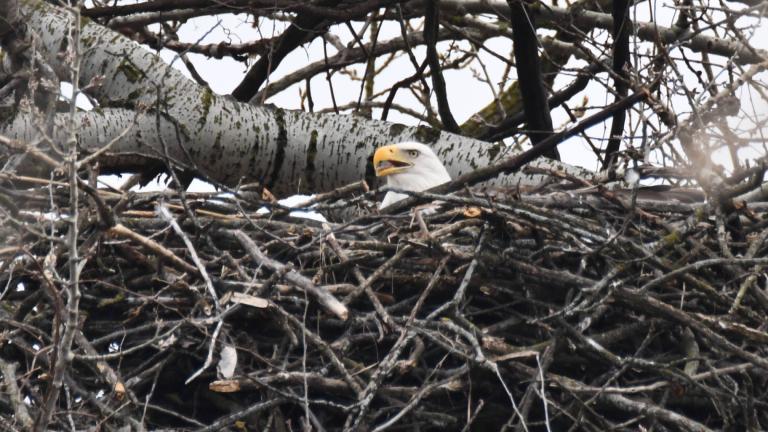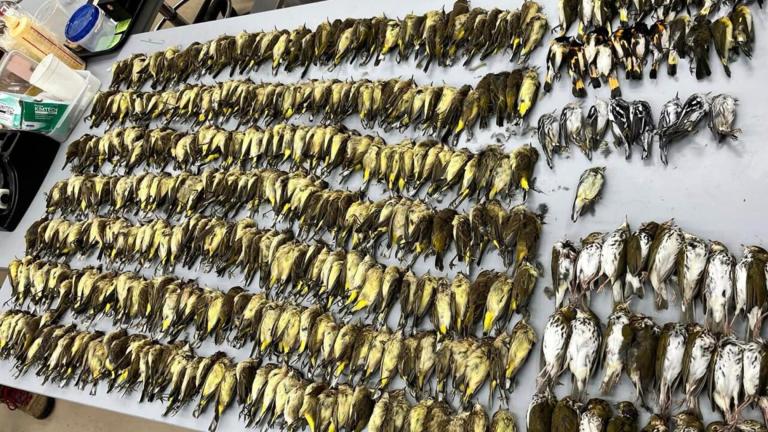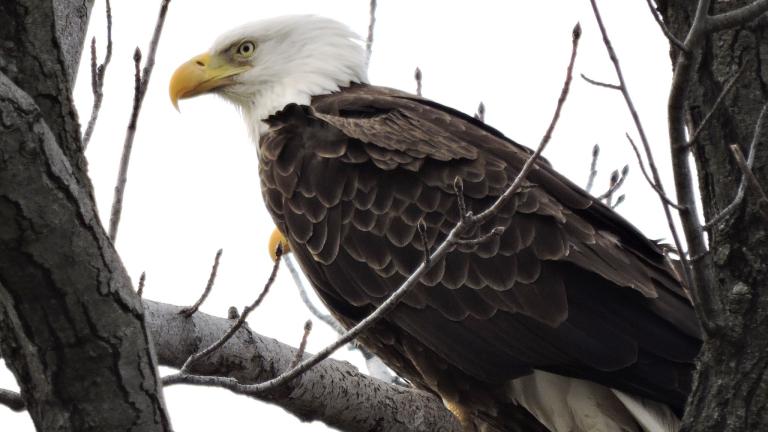 A black-crowned night heron, in its signature hunched stance, with long white streamers just visible. (Dulcey Lima / Unsplash)
A black-crowned night heron, in its signature hunched stance, with long white streamers just visible. (Dulcey Lima / Unsplash)
Bird A-24 is going to need a snazzier name.
That’s the ID code given to one of six black-crowned night herons (Nycticorax nycticorax) researchers outfitted with tracking transmitters over the summer as part of an effort to learn more about the comings and goings of members of Lincoln Park Zoo’s night heron colony, the largest breeding colony in the Midwest.
In recent days, A-24’s transmitter has pinged receivers in Tennessee, then multiple points in Georgia and most recently Florida, near Gainesville. If A-24 continues to deliver such valuable data, he or she — male and female black-crowned night herons are fairly indistinguishable from each other — will have made significant contributions to science and earned a place among the city’s Montys and Roses.
Because as it turns out, those high-tech “spottings” of A-24 are scientists’ first-ever insights into the migratory movements of Chicago’s night heron colony, which until now have been a complete mystery.
Unlike, say, the well-documented north-south patterns of Great Lakes piping plovers, black-crowned night herons, as a species, have a pretty wide range of migratory behaviors, according to Henry Adams, wildlife management coordinator for Lincoln Park Zoo’s Urban Wildlife Institute.
Some of them are residential, meaning they live in a place year-round, he explained, while others are short-range, mid-range or long-range migrants. Short-range might travel 100 miles, maybe popping over to a neighboring state; mid-range will migrate a couple hundred miles, which, from Illinois, would put them in Kentucky or Tennessee; and long-range migrants will wing their way 1,000 miles south, or further.
But aside from studies conducted on colonies from New York, Ohio and Washington, D.C., “not a lot of migratory and robust movement work has been done” on night herons, Adams said.
“We really don’t know what the birds in Chicago and in Illinois are doing,” he continued. “Ohio and D.C. (night herons) are over-wintering in southern Florida and parts of the Caribbean. So we’re really interested to see if our birds are also migrating to those similar places, and if they have what’s called high migratory connectivity to these other migrating populations.”
If the zoo’s birds do have an established wintering site, advocates in Chicago can team up with their southern counterparts to promote habitat conservation. On the flip side, if there are residential night herons sticking out the winter in Chicago, scientists are keen to discover where the birds are finding food or sheltering.
“Those questions, that’s why we’re doing this research,” said Adams, who’s leading a team that also includes the University of Illinois, the Bird Conservation Network, Illinois Department of Natural Resources and the Chicago Black-crowned Night-Heron Project.
The more scientists can learn about the Chicago colony’s habits and needs, he said, the more they can help these night herons help themselves. Because this once plentiful bird is hanging on in Illinois by a thread.
Too Many Eggs in a Single Basket
Though black-crowned night herons are fairly common and their overall conservation status is “low concern,” the bird has been state listed as endangered in Illinois since 1977.
Loss of the night herons’ wetland habitat due to agricultural and urban development is largely to blame. And that’s what makes the bird’s presence in Chicago — as well as New York, D.C. and Cleveland — all the more interesting.
“It’s odd for an endangered species to be that tied into urban areas,” said Michael Ward, professor in the Department of Natural Resources and Environmental Sciences at the University of Illinois. “This bird is different. It doesn’t need pristine habitat.”
In fact, night herons had a successful breeding colony in the highly degraded Calumet region for years before flooding sent them north to Lincoln Park roughly a decade ago.
In 2022, the Urban Wildlife Institute counted 750 adult night herons nesting in Lincoln Park — the most since the zoo began studying the colony in 2010 — and more than 400 young. This year, though there were fewer adults — 690, “still a ton of adults,” Adams said — the colony enjoyed an even bigger baby boom.
“The really exciting thing is that we have seen significant increases in productivity of the colony since 2011, and this year was the most productive year the colony has ever had,” said Adams. “We documented 480 hatch year birds, so it was a really fabulous year reproductively speaking.”
The worry, though, is that when it comes to black-crowned night herons, Illinois has all of its eggs in a single basket, said Ward. A storm could wipe out the birds’ favorite nesting trees or a pathogen could spread among the colony or a single raccoon could wreak havoc.
“If we lost the Lincoln Park Zoo colony, black-crowned night herons would be extirpated (locally extinct) in Illinois,” he said.
In 2021, a construction project on the grounds of the Chicago History Museum, where some 45 pairs of night herons historically nested, caused the adults to abandon their nests and they haven’t returned to breed. Though Ward said he believes the museum birds were functioning as part of one large colony with the zoo, the loss of that nesting site demonstrates the fragility of the toehold night herons have in Chicago.
So in addition to the tracking aspect of the research project, the night heron team is also attempting to convince the birds to spread their wings and establish additional rookeries elsewhere in the area.
With colonial birds, one member makes the first decision to nest somewhere and others follow. For whatever reason, Chicago’s night herons have followed a trailblazer that’s seemingly chosen poorly, said Ward.
To point the birds in the direction of restored wetland habitat, decoy models were placed in Big Marsh Park and MP3 players were affixed to trees, broadcasting sounds of adult and baby night herons, to kind of trick the birds into considering sites outside of the zoo’s grounds.
“For whatever reason, these birds just haven’t been exposed to those (restored) areas. It’s our job to do our best to say, ‘Hey, this resource is here for you. Would you like to use it?’ And they can say, ‘Yeah, that sounds great,’ or, ‘Nope, I’m good, I’m going back to the zoo,’” Adams said.
“And beyond that, that’s really all that in my opinion us as ecologists can do. Try to best understand what these birds need, what these birds are looking for and say, ‘Oh there’s a great thing over here, maybe you want to try that out.’ Then it’s kind of up to them,” he said.
Though named for its famous black crown, the night heron's most distinctive physical trait is perhaps the long white plumes that extend from the back of its head. (Patty Wetli / WTTW News)
In the event the night herons continue to show a preference for Chicago’s urban environment, ecologists would like to set them up for success. To that end, the research team is taking a close look at the zoo’s nesting site to get a sense of what is and isn’t working for the birds.
“Is it presenting greater opportunities? Is it providing neutral opportunities, as in they experience some negative aspects of living in an urban environment, but some positive aspects of living in an urban environment? Those are all the questions that we’re really interested in asking and hopefully answering,” said Adams.
His team has conducted a survey of every night heron nest in the zoo — there can be a dozen nests in a single tree — measuring the height of the nest, the height of the tree, the species of tree (maples and alders seem to be the most popular). How does this jibe with the bird’s preference to nest on an island or over water?
Researchers are also documenting which trees the night herons aren’t choosing, and will run this “presence and absence” data through a model to predict the most influential micro-habitat factors.
“Then after we answer the question of do they love maples, next is why do they love maples? Is it the structure, is it the angle that the branches have to the trunk of the tree? Is it the way that the branches grow? And if it is something like that, are there alternative native species that we can be planting instead of these maples?” Adams asked.
Diet is another angle ripe for investigation, using the same transmitter technology deployed in the migration study.
Assuming A-24 and the other tagged night herons return to Chicago next year, researchers can track where the birds go to forage for food and then analyze blood or fecal samples to identify what they’ve eaten.
Are certain night herons heading to River Park and dining on crayfish? Or are they winging to Navy Pier and chowing on french fries?
“We can put all of those puzzle pieces together in a really exciting way,” Adams said.
Perseverance and Ingenuity
It took breakthroughs in transmitter technology to make the night heron project possible. And then perseverance and ingenuity to make it a reality.
In the past, tracking tags were too large and too heavy to use on birds, but today’s transmitters are exponentially smaller and lighter, to the point where a night heron could handle the weight.
But getting the trackers on the birds proved a bigger challenge than the research team anticipated.
Ward used buckets of minnows as a lure to no avail. Nets and remote control traps at the bird’s foraging sites were also futile.
Finally the team set up walk-in enclosures at the zoo, careful to time the process so it wouldn’t interfere with breeding. And that turned out to be the secret sauce.
“It’s just so much easier to go to the source of these birds instead of trying to work with them in their foraging habitat,” said Adams. “They were just so much more curious and likely to check out these walk-in enclosures when we brought them to their home base. Think about ourselves: We feel so comfortable at home, that we’re a little bit more likely to explore new things. Whereas when we’re a bit far afield or out of our comfort zone, our curiosity will probably diminish a little bit. And the same, I think, can be said for these herons.”
The team ultimately tagged three adults and three juveniles, and was able to band dozens more. Now it’s a waiting game to see where A-24 and the others turn up. For people interested in following along at home, the tracking “pings” can be viewed through the app Animal Tracker, which is available for free download. Just search “black-crowned night heron” and the results will all lead to the zoo’s birds.
For his part, Adams is already looking forward to next spring and welcoming the night herons home.
“We’ll hopefully start seeing them returning to Chicago, returning to the breeding colony, and we might be able to see, ‘Oh my gosh, look at that, that’s A-15. They do use the exact same boulder every single time when they’re hanging out at River Park,’” said Adams. “So I’m really excited to start seeing the return on investment.”
Gone Fishing
If “heron” conjures up an image of an elegant wader with legs for days, well, black-crowned night herons are here to paint a different picture.
Their appearance is, in some ways, closer to a penguin’s (at least one Bostonian made that hilarious mistake), except instead of a tuxedo, night herons look more like the Monopoly Man, decked out in a robber baron’s three-piece suit with waistcoat.
The bird’s already stocky build becomes even more compact when night herons adopt their signature hunched stance, giving them what Adams described as “grumpy old geezer energy.”
Video: Catch of the day. Night heron in River Park. (Patty Wetli / WTTW News)
Don’t be fooled though, he said. Night herons are “sit-and-wait” predators and what looks like a stumpy neck is actually accordion-like in its ability to elongate.
“They just stare at the water waiting for an opportunity to strike. And then they’ll use that spring-loaded neck and spearlike bill to snag some fish or other aquatic food morsel,” Adams said.
Contact Patty Wetli: @pattywetli | (773) 509-5623 | [email protected]

